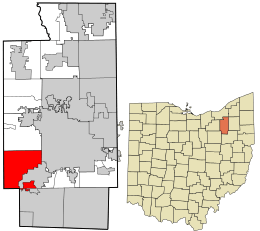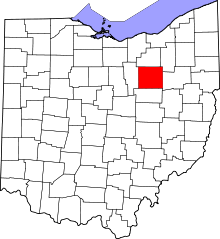Norton, Ohio
| Norton, Ohio | |
|---|---|
| City | |
|
Silver Creek Metropark is located in Norton | |
 Location in Summit County and the state of Ohio. | |
| Coordinates: 41°1′31″N 81°38′38″W / 41.02528°N 81.64389°WCoordinates: 41°1′31″N 81°38′38″W / 41.02528°N 81.64389°W | |
| Country | United States |
| State | Ohio |
| Counties | Summit, Wayne |
| Government | |
| • Mayor | Mike Zita |
| Area[1] | |
| • Total | 20.49 sq mi (53.07 km2) |
| • Land | 20.16 sq mi (52.21 km2) |
| • Water | 0.33 sq mi (0.85 km2) |
| Elevation[2] | 1,066 ft (325 m) |
| Population (2010)[3] | |
| • Total | 12,085 |
| • Estimate (2012[4]) | 12,030 |
| • Density | 599.5/sq mi (231.5/km2) |
| Time zone | Eastern (EST) (UTC-5) |
| • Summer (DST) | EDT (UTC-4) |
| ZIP code | 44203 |
| Area code(s) | 330, 234 |
| FIPS code | 39-57260[5] |
| GNIS feature ID | 1071010[2] |
| Website | http://www.cityofnorton.org/ |
Norton is a city in Summit and Wayne counties in the U.S. state of Ohio. The population was 12,085 at the 2010 census.
The Summit County portion of Norton is part of the Akron Metropolitan Statistical Area, while the small portion in Wayne County is part of the Wooster Micropolitan Statistical Area.
History
In 1818, Norton Township was organized. It was originally a part of Wolf Creek Township which consisted of present-day Norton, Copley, Wadsworth, Sharon, Guilford, and Montville townships. Norton Township was surveyed by Joseph Darrow and plotted into lots half a mile square. Norton was known as Town 1, Range 12 of the Western Reserve. It was named after Birdseye Norton, one of the original owners of the township. The first two people to settle on this land, in 1810, were James Robinson and John Cahow. Robinson purchased lot 19 and Cahow lot 20. It is a matter of some dispute as to whether Robinson’s or Cahow’s house was the first one built in the township. The first marriage in the township was in the fall of 1814 between James Robinson and Lois Bates. The first tavern was built by John Cahow on his lot 20 in 1812. The first saw and grist mills were built by Thomas Johnson in 1823 (saw) and 1830 (grist). Norton Township consisted of seven small villages: Loyal Oak (Also known as Bates' Corners located at 261 & Cleveland-Massillon Rd), Western Star (Greenwich and Medina Line Roads), Sherman (Originally known as Dennison located at Hametown Rd & Sherman St), Johnson's Corners (31st St & Wooster Rd W), Norton Center (Cleveland-Massillon & Greenwich Rd & Norton Ave), Hametown (Hametown and Wooster Roads), and New Portage (Wooster Rd N & Norton Ave.). One of Norton's famous families is the Seiberling family; Frank A. and Charles W. Seiberling started the Goodyear tire and rubber company in 1898. The Seiberling farm is still in operation today on Greenwich Road at Knollbrook Drive. In 1890, Ohio Columbus Barber, Charles Baird, Albert T. Paige and John K. Robinson purchased a number of farms adjacent to New Portage. Their purchase was for the purpose of founding a new manufacturing city. This city was named Barberton after O. C. Barber. The Ohio & Erie Canal ran through the southeastern part of the township from 1827-1913. Electric trolley lines were installed from Barberton to Wadsworth through Norton in 1905. In 1958 the Norton Township Development Committee was formed. Residents believed the Township form of government, with its three Trustees, needed a more structured form of government to effectively meet the needs of a fast-growing community. After time, an issue to incorporate as a village was placed on the election ballot. Although defeated the first time, it passed in 1961, thus incorporating Norton as a village. Norton’s first Village Mayor was Richard DuFore. The General Election of November 1968, brought Norton to a City status. The former Norton Village officially assumed City status on January 11, 1969. Norton's current government consists of Mayor Mike Zita and council members: Rick Rodgers, Dennis McGlone, Dennis Pierson, Paul Tousley, Joe Kernan, Scott Pelot, and Charlotte Whipkey.[6][7][8]
Geography
Norton located at 41°1′31″N 81°38′38″W / 41.02528°N 81.64389°W (41.025283, -81.643786),[9] almost entirely in Summit County, with just a small portion containing several parcels in Wayne County.[10][11]
According to the United States Census Bureau, the city has a total area of 20.49 square miles (53.07 km2), of which, 20.16 square miles (52.21 km2) is land and 0.33 square miles (0.85 km2) is water.[1]
Demographics
| Historical population | |||
|---|---|---|---|
| Census | Pop. | %± | |
| 1970 | 12,308 | — | |
| 1980 | 12,242 | −0.5% | |
| 1990 | 11,477 | −6.2% | |
| 2000 | 11,523 | 0.4% | |
| 2010 | 12,085 | 4.9% | |
| Est. 2015 | 12,036 | [12] | −0.4% |
| Sources:[5][13][14] | |||
2010 census
As of the census[3] of 2010, there were 12,085 people, 4,711 households, and 3,439 families residing in the city. The population density was 599.5 inhabitants per square mile (231.5/km2). There were 4,951 housing units at an average density of 245.6 per square mile (94.8/km2). The racial makeup of the city was 96.2% White, 1.7% African American, 0.2% Native American, 0.8% Asian, 0.1% Pacific Islander, 0.1% from other races, and 1.0% from two or more races. Hispanic or Latino of any race were 0.9% of the population.
There were 4,711 households of which 29.7% had children under the age of 18 living with them, 59.4% were married couples living together, 9.0% had a female householder with no husband present, 4.6% had a male householder with no wife present, and 27.0% were non-families. 22.4% of all households were made up of individuals and 9.5% had someone living alone who was 65 years of age or older. The average household size was 2.53 and the average family size was 2.96.
The median age in the city was 43.7 years. 21.8% of residents were under the age of 18; 7.1% were between the ages of 18 and 24; 23.1% were from 25 to 44; 31.9% were from 45 to 64; and 16.1% were 65 years of age or older. The gender makeup of the city was 49.3% male and 50.7% female.
2000 census
As of the census[5] of 2000, there were 11,523 people, 4,343 households, and 3,361 families residing in the city. The population density was 572.8 people per square mile (221.1/km²). There were 4,523 housing units at an average density of 224.8 per square mile (86.8/km²). The racial makeup of the city was 97.35% White, 1.34% African American, 0.17% Native American, 0.28% Asian, 0.03% Pacific Islander, 0.14% from other races, and 0.69% from two or more races. Hispanic or Latino of any race were 0.41% of the population.
There were 4,343 households out of which 31.0% had children under the age of 18 living with them, 65.9% were married couples living together, 8.5% had a female householder with no husband present, and 22.6% were non-families. 19.3% of all households were made up of individuals and 9.0% had someone living alone who was 65 years of age or older. The average household size was 2.64 and the average family size was 3.01.
In the city the population was spread out with 24.5% under the age of 18, 6.9% from 18 to 24, 27.4% from 25 to 44, 25.9% from 45 to 64, and 15.3% who were 65 years of age or older. The median age was 40 years. For every 100 females there were 96.6 males. For every 100 females age 18 and over, there were 95.6 males.
The median income for a household in the city was $47,085, and the median income for a family was $50,737. Males had a median income of $38,289 versus $25,687 for females. The per capita income for the city was $20,661. About 4.3% of families and 5.9% of the population were below the poverty line, including 7.1% of those under age 18 and 4.4% of those age 65 or over.
Public safety
Norton operates a police department and a fire department with two fire stations.
Proposed power plant
A compressed air energy storage facility able to provide up to 2700 MW of power has been proposed to be built in the city. First Energy Corporation of Akron, Ohio purchased rights to develop plant in November 2009.
Traditions
The city holds a yearly Apple Cider Festival in September. It includes a parade, fireworks, crafts and attractions. Begun by the Lions Club in 1988, the family members thought about starting an Octoberfest, but decided that since the Lions were known for selling cider in the Loyal Oak area of the City, that a Cider Festival would best suit the residents of that area. On September 23 and 24, 1989, the first Cider Festival was held as a local community event. For the 20th Anniversary in 2008, the location of the Festival was changed to be held closer to the City center at the Columbia Woods Park complex.
References
- 1 2 "US Gazetteer files 2010". United States Census Bureau. Retrieved 2013-01-06.
- 1 2 "US Board on Geographic Names". United States Geological Survey. 2007-10-25. Retrieved 2008-01-31.
- 1 2 "American FactFinder". United States Census Bureau. Retrieved 2013-01-06.
- ↑ "Population Estimates". United States Census Bureau. Retrieved 2013-06-17.
- 1 2 3 "American FactFinder". United States Census Bureau. Retrieved 2008-01-31.
- ↑ http://www.cityofnorton.org/General%20Info/History/AreaHistory.htm
- ↑ http://www.cityofnorton.org/General%20Info/History/GovtHistory.htm
- ↑ http://www.historicmapworks.com/Map/US/162489/History+006/Summit+County+1891/Ohio/
- ↑ "US Gazetteer files: 2010, 2000, and 1990". United States Census Bureau. 2011-02-12. Retrieved 2011-04-23.
- ↑ "Subcounty population estimates: Ohio 2000-2006". United States Census Bureau, Population Division. 2007-06-28. Archived from the original (CSV) on 2008-04-20. Retrieved 2008-05-28.
- ↑ The Board of Wayne County Commissioners (2005). "Wayne County Ohio Government Web Site / Maps Office:". Wayne County Map Office: Norton. Retrieved 2015-05-28.
- ↑ "Annual Estimates of the Resident Population for Incorporated Places: April 1, 2010 to July 1, 2015". Retrieved July 2, 2016.
- ↑ "Ohio: Population and Housing Unit Counts" (PDF). U.S. Census Bureau. Retrieved 22 November 2013.
- ↑ "Incorporated Places and Minor Civil Divisions Datasets: Subcounty Population Estimates: April 1, 2010 to July 1, 2012". U.S. Census Bureau. Retrieved 25 November 2013.


